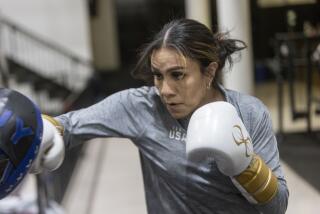Japan Has Run Out of Fighting Haradas : Former Champion Says That Is Price It Has to Pay for Todayâs Prosperity
TOKYO â To hear one of their old warriors tell it, the Japanese have paid a price for their rise, within two generations, from the ashes of World War II to their present-day economic diversity and prosperity.
The price: There are no more Fighting Haradas.
The source for this: Fighting Harada.
He looked down upon the noisy street traffic from his second-floor gym in downtown Tokyo recently and talked about a long search.
âEvery day, I wait for a young Fighting Harada to walk through that door over there, and Iâve been waiting 18 years,â said Harada, through a translator.
âWhen I began boxing, in the late 1950s, Japan was poor. The gyms were full, full of young men like me who saw opportunity in boxing. Today, our gyms are not very busy.â
He waved his hand, indicating four young boxers who were working out in mid-afternoon, shadow-boxing or jumping rope. It looked pretty much like any gym in Downtown, America, except for one thing: Visitors park their shoes in a shoe rack at the front door and slip into a pair of sandals.
At the window, Harada looked down again and pointed to about a half-dozen young men roaring by on big, new motorcycles. They wore expensive sunglasses and laughed a lot. Harada shook his head in moderate disgust. He made a comment about the 1950s, and how bicycles were hard to come by then.
âWhen I started out in boxing, in the late 1950s, this was a poor country,â he said. âNo one owned much of anything. Now, look around. Itâs a rich, wealthy country. People can buy anything. Why be a boxer? Itâs a tough, hard sport.
âWe all began to notice the difference after the (1964) Olympics, when we began to become more prosperous. But as we became richer, we lost a certain spirit, I think--the spirit that I had, and the men who boxed when I did.â
Masahiko (Fighting) Harada. Twenty-five years ago, when he was a sinewy 112-pounder, he fought like a one-half scale model Mike Tyson. Only two Japanese fighters have ever been world champions in two weight divisions, Harada and Kuniaki Shibata. And both were born during or immediately after World War II.
Harada fought at weights from 112 to 120 pounds. The 5-foot 4-inch Harada, now 45, is a broad-faced, broad-bodied 156 pounds.
He won the world flyweight championship when he knocked out Thailandâs Pone Kingpetch in 1962. In a 1963 rematch, he lost the title back to Kingpetch and then moved up in weight to the bantamweight division. In 1965, he defeated Eder Jofre of Brazil to win the bantamweight championship.
He defended the title four times before losing it, in 1968, to the Australian aborigine, Lionel Rose. Twice, Harada tried unsuccessfully to win the featherweight title, finally retiring in 1970.
Los Angeles boxing promoter Don Fraser remembers Harada as Mr. Man in Motion. Harada fought once in Los Angeles, gaining a 10-round decision over Ray Asis in 1964.
âHe was kind of a mini-Tyson of his day,â Fraser recalled. âHe was very strong, an all-action guy, always in your face, never stopped punching. He was a superbly conditioned fighter. He was like a little toy--when the bell rang, he came racing out of his corner, and he threw non-stop punches until the bell rang again.â
In the late 1950s and throughout the 1960s, Japanese names dominated the monthly Ring Magazine world ratings in the light weight classes. Today, there are a smattering of Japanese names, with Thais, South Koreans and Latins. One boxing publication, KO Magazine, in a recent issue, ranked just one Japanese fighter in its flyweight, bantamweight and junior featherweight rankings.
In Haradaâs day, Japanese fighters were preeminent. Shibata, a contemporary of Haradaâs, fought in 13 world championship bouts between 1970 and 1975. He won the featherweight championship in Tijuana in 1970 by knocking out Vicente Saldivar.
He defended that title twice before losing it, then moved up to the junior lightweights and won that title in 1973.
Flyweight Yoshio Shirai, born in 1923, was a fighter during World War II. The Ring Record Book lists him as having fought eight times in 1943 and â44. In 1952, he became the world flyweight champion and defended the title four times, losing it in 1954. Heâs the only Japanese fighter elected to Ring Magazineâs boxingâs hall of fame.
In Japan, some other best-remembered names associated with the countryâs golden era of boxing (1955-1975) include Hiroshi Kobayashi, Hidemasa Nagashima, Shozo Saijo, Hiroyuki Ebihara and Masao Ohba.
They were tough, hard little men, up from the tough, hard streets of postwar Japan.
Harada watched two young boxers spar. He called a halt, then went into the ring and scolded one for not keeping his elbows tight to his rib cage. Then he emerged, to talk about his father.
âMy father told me when I was young that there were three paths to success: to go to school and study hard, to create a successful business of some kind, or to achieve a great victory in some activity, and he was talking about boxing.â
The heavyweight champion, Mike Tyson, defeated Tony Tubbs in Tokyo recently, and as part of the prefight buildup, Tyson executed a masterstroke of public relations. The Japanese were already fascinated by Tyson, but at a New York press conference televised live to Japan in February, Tyson made them fall in love with him.
Talking directly to sportswriters in Japan, Tyson said:
âI would like to acknowledge a great champion of your country, Fighting Harada. Iâm a great admirer of his. I have studied a film of his fight with Eder Jofre. I admire Fighting Haradaâs nonstop style. He was a very disciplined fighter.â
Harada was seated in the front row in Tokyo, watching the news conference telecast, and said he was honored by the unexpected remarks.
âI have been a lucky man, to have had a successful sports career, to have people here in my own country approach me on the street who recognize me. And now, for Mike Tyson to have said that, I am truly honored.
Japanese, he said, admire Tysonâs âspirit.â
âJapanese sports fans admire any athlete who works hard at what he does, and Tyson seems to work harder at his sport than anyone they know about,â he said.
âI visited Mike at his hotel when he was here, and we had a nice visit. I invited him to dinner and he declined, because he said it would be âplay,â and that he was in Japan to prepare for an opponent. I greatly admired that attitude. And so did all of Japanâs boxing fans, when they read in the newspapers that all of the Tyson people were in a Tokyo disco until 3 a.m.--except Tyson.
âAnd a lot of people in Japan think Tyson may have changed the way boxers fight. Before, so many used the âfloat like a butterfly, sting like a beeâ style of Muhammad Ali. Now, we think a lot more boxers, particularly heavyweights, will be fighting with the all-out intensity of Mike Tyson.â
Or of Fighting Harada.
The boxing gym business in Tokyo (surprisingly, there are about 50 of them, Harada said) will be booming about now, according to Harada.
âEvery time the movie âRockyâ or a Mike Tyson fight is on TV, a lot of young men come into the gym to learn how to box, but they are only here for about six weeks. After that, they are gone. See? Boxing is so much more difficult to master than almost anything else.
âItâs no longer like it was.â
More to Read
Go beyond the scoreboard
Get the latest on L.A.'s teams in the daily Sports Report newsletter.
You may occasionally receive promotional content from the Los Angeles Times.










